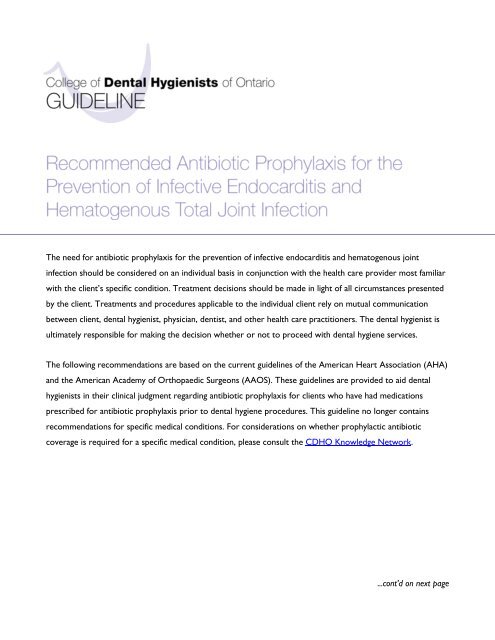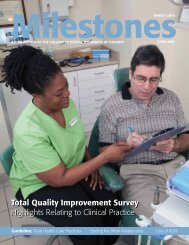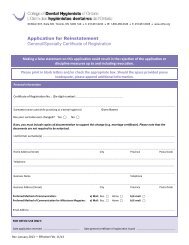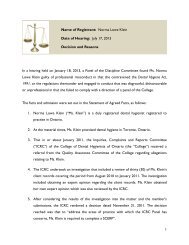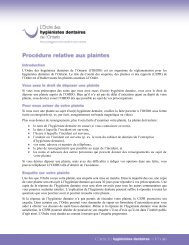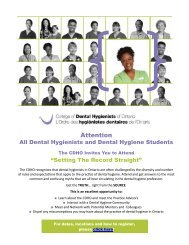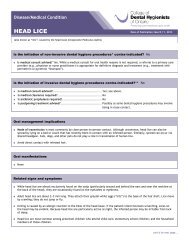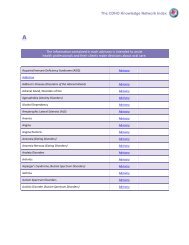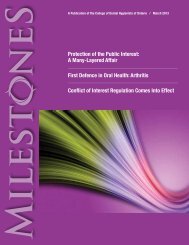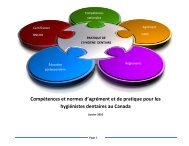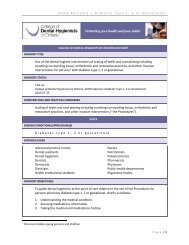Recommended Antibiotic Prophylaxis for the Prevention - College Of ...
Recommended Antibiotic Prophylaxis for the Prevention - College Of ...
Recommended Antibiotic Prophylaxis for the Prevention - College Of ...
You also want an ePaper? Increase the reach of your titles
YUMPU automatically turns print PDFs into web optimized ePapers that Google loves.
The need <strong>for</strong> antibiotic prophylaxis <strong>for</strong> <strong>the</strong> prevention of infective endocarditis and hematogenous joint<br />
infection should be considered on an individual basis in conjunction with <strong>the</strong> health care provider most familiar<br />
with <strong>the</strong> client’s specific condition. Treatment decisions should be made in light of all circumstances presented<br />
by <strong>the</strong> client. Treatments and procedures applicable to <strong>the</strong> individual client rely on mutual communication<br />
between client, dental hygienist, physician, dentist, and o<strong>the</strong>r health care practitioners. The dental hygienist is<br />
ultimately responsible <strong>for</strong> making <strong>the</strong> decision whe<strong>the</strong>r or not to proceed with dental hygiene services.<br />
The following recommendations are based on <strong>the</strong> current guidelines of <strong>the</strong> American Heart Association (AHA)<br />
and <strong>the</strong> American Academy of Orthopaedic Surgeons (AAOS). These guidelines are provided to aid dental<br />
hygienists in <strong>the</strong>ir clinical judgment regarding antibiotic prophylaxis <strong>for</strong> clients who have had medications<br />
prescribed <strong>for</strong> antibiotic prophylaxis prior to dental hygiene procedures. This guideline no longer contains<br />
recommendations <strong>for</strong> specific medical conditions. For considerations on whe<strong>the</strong>r prophylactic antibiotic<br />
coverage is required <strong>for</strong> a specific medical condition, please consult <strong>the</strong> CDHO Knowledge Network.<br />
...cont’d on next page
Table 1 – <strong>Antibiotic</strong> <strong>Prophylaxis</strong> Recommendations<br />
(No follow-up dose recommended)<br />
Situation Agent Regimen*<br />
Standard general<br />
prophylaxis:<br />
Amoxicillin, Cephalexin**<br />
2.0 g orally<br />
30–60 minutes be<strong>for</strong>e procedure<br />
Unable to take oral<br />
medications:<br />
Ampicillin<br />
Cefazolin<br />
2.0 g IM or IV<br />
30–60 minutes be<strong>for</strong>e procedure<br />
1.0 g IM or IV<br />
30–60 minutes be<strong>for</strong>e procedure<br />
Penicillin-allergic: Clindamycin 600 mg orally<br />
30–60 minutes be<strong>for</strong>e procedure<br />
Penicillin-allergic and<br />
unable to take oral<br />
medications:<br />
Clindamycin<br />
600 mg IV<br />
30–60 minutes be<strong>for</strong>e procedure<br />
*No follow-up dose recommended.<br />
**Cephalosporins should not be used in individuals with immediate type hypersensitivity reaction (urticaria,<br />
angioedema or anaphylaxis) to penicillins.<br />
For children, please consult <strong>the</strong>ir physician.<br />
Please Note: Prior antibiotic use should be considered be<strong>for</strong>e prophylactic antibiotics are prescribed as<br />
resistant organisms may develop. If <strong>the</strong> need <strong>for</strong> prophylaxis closely follows prior antibiotic exposure<br />
(i.e., within 9 to 14 days), an antibiotic from a different antibiotic class should be considered.
Table 2 – <strong>Antibiotic</strong> <strong>Prophylaxis</strong> Recommendations <strong>for</strong> Adult Clients at Risk <strong>for</strong> Infective<br />
Endocarditis Who Require Multiple Dental Hygiene Appointments Within a 9-Day Period<br />
(No penicillin allergy)<br />
Appointment<br />
First<br />
Second (2–4 days later)<br />
Third (2–4 days later)<br />
Fourth (2–4 days later)<br />
Fifth (2–4 days later)<br />
Drug Regimen (Oral Dosages)<br />
(30–60 mins be<strong>for</strong>e appointment)<br />
Amoxicillin 2.0 g<br />
Macrolide (clarithromycin or azithromycin) 500 mg<br />
Clindamycin 600 mg<br />
Amoxicillin or cephalexin 2.0 g<br />
Macrolide<br />
The above Recommendations are <strong>for</strong> adult clients, with no penicillin allergy, who are at risk <strong>for</strong> infective<br />
endocarditis (due to <strong>the</strong> specified heart conditions and <strong>the</strong> dental procedures listed in <strong>the</strong> 2007 AHA<br />
protocols).<br />
These recommendations are <strong>for</strong> clients returning <strong>for</strong> multiple appointments within <strong>the</strong> 9-day period, but on<br />
different days. One of <strong>the</strong> best ways to eliminate this need <strong>for</strong> a “rotational schedule” of <strong>the</strong> antibiotics is to<br />
schedule <strong>the</strong> client’s multiple appointments at least 10–14 days apart. Using <strong>the</strong> same antibiotic between dental<br />
hygiene appointments that are scheduled within a 9-day period increases <strong>the</strong> risk <strong>for</strong> resistance and may<br />
reduce <strong>the</strong> efficacy of <strong>the</strong> drug.<br />
If you need to follow a rotational schedule <strong>for</strong> a client who is allergic to penicillin, eliminate amoxicillin in <strong>the</strong><br />
rotation. Depending on <strong>the</strong> allergy, you may also determine that cephalosporins are contraindicated. One of<br />
<strong>the</strong> macrolide antibiotics or clindamycin should be considered instead.<br />
If a client requires premedication and has multiple appointments on <strong>the</strong> same day, Table 2 would not apply.<br />
The client should take an additional dose of <strong>the</strong> same drug not a second alternative drug and <strong>the</strong><br />
determination regarding whe<strong>the</strong>r an additional dose is required, as well as <strong>the</strong> amount of <strong>the</strong> drug needed<br />
depends on a number of variables, including <strong>the</strong> half-life of <strong>the</strong> drug, <strong>the</strong> age of <strong>the</strong> client and whe<strong>the</strong>r or not<br />
<strong>the</strong>y have any impairments (e.g., liver) that would slow down <strong>the</strong> absorption, distribution, metabolism, and<br />
excretion process. If unsure whe<strong>the</strong>r an additional dose is needed, <strong>the</strong> dental hygienist should consult with <strong>the</strong><br />
prescriber and/or a pharmacist.<br />
Table 2 and Decision Making Using <strong>the</strong> <strong>Antibiotic</strong> <strong>Prophylaxis</strong> Recommendations in Table 2 were<br />
adapted and used with <strong>the</strong> permission from <strong>the</strong> <strong>College</strong> of Registered Dental Hygienists of Alberta.
Table 3 – Bacteremic Dental Procedures<br />
<strong>Antibiotic</strong> <strong>Prophylaxis</strong> <strong>Recommended</strong> 1<br />
Dental procedures that involve manipulation of gingival tissue or <strong>the</strong> periapical region<br />
of <strong>the</strong> teeth or per<strong>for</strong>ation of <strong>the</strong> oral mucosa 2<br />
Scaling and root planing of teeth<br />
Periodontal procedures<br />
Tooth extraction<br />
Suture removal<br />
Biopsies<br />
•Curetting tissue<br />
•Periodontal probing<br />
•Periodontal surgery<br />
•Subgingival placement of antibiotic fibers and strips<br />
Prophylactic cleaning of teeth or implants where bleeding is anticipated<br />
Dental implant placement and replantation of avulsed teeth<br />
Endodontic instrumentation or surgery only beyond <strong>the</strong> apex<br />
Placement of orthodontic bands<br />
Intraligamentary and intraosseous local anaes<strong>the</strong>tic injections<br />
1 Table 3 lists dental procedures that may increase <strong>the</strong> risk of infectious endocarditis in accordance with AHA guidelines.<br />
2 The following procedures and events do not need prophylaxis: routine anaes<strong>the</strong>tic injection through non-infected tissue, taking radiographs,<br />
placement of removable pros<strong>the</strong>tic or orthodontic appliances, adjustment of orthodontic appliances, placement of orthodontic brackets, shedding<br />
of deciduous teeth, and bleeding from trauma to <strong>the</strong> lips or oral mucosa.<br />
Occasionally, a client may present with a recommendation <strong>for</strong>, or against, prophylactic antibiotic coverage from<br />
his/her physician that is not consistent with <strong>the</strong> CDHO, AHA, or AAOS guidelines. The dental hygienist is to<br />
consult with <strong>the</strong> physician (primary or specialized care provider) to determine if <strong>the</strong>re are any special<br />
considerations that would affect a decision whe<strong>the</strong>r or not to pre-medicate. The dental hygienist should have<br />
a copy of <strong>the</strong> CDHO advisory specific to <strong>the</strong> medical condition and <strong>the</strong>se guidelines available to <strong>the</strong> physician<br />
<strong>for</strong> consultation if appropriate. The need <strong>for</strong> antibiotic coverage <strong>for</strong> <strong>the</strong>se clients should be considered on an<br />
individual basis in conjunction with <strong>the</strong> client’s physician (primary or specialized care provider). The dental<br />
hygienist is ultimately responsible <strong>for</strong> making <strong>the</strong> decision whe<strong>the</strong>r or not to proceed with dental hygiene<br />
services.
Dental hygienists are reminded that <strong>the</strong>y are responsible <strong>for</strong> <strong>the</strong> treatment <strong>the</strong>y render. If <strong>the</strong> dental hygienist<br />
does not believe that it is in <strong>the</strong> best interest of <strong>the</strong> client to proceed with treatment, <strong>the</strong>y must not do so. It<br />
is both unethical and illegal <strong>for</strong> <strong>the</strong> dentist to insist that treatment be per<strong>for</strong>med by <strong>the</strong> dental hygienist when<br />
<strong>the</strong>re are doubts as to <strong>the</strong> medical condition of <strong>the</strong> client. To provide maximum protection against sub-acute<br />
bacterial endocarditis, prophylactic antibiotics must be administered 30 to 60 minutes prior to <strong>the</strong><br />
commencement of any procedure that might induce bleeding. The dental hygienist should always ask<br />
if <strong>the</strong> client has taken <strong>the</strong> medication and document that fact. The CDHO takes <strong>the</strong> position that dental<br />
hygienists are responsible <strong>for</strong> in<strong>for</strong>ming <strong>the</strong> client of <strong>the</strong> possible consequences of treatment that may occur<br />
if <strong>the</strong> prophylactic antibiotics have not been taken within <strong>the</strong> specified time period. If, following a detailed<br />
explanation of <strong>the</strong> risks and benefits of prophylactic coverage to <strong>the</strong> client and if <strong>the</strong> dental hygienist is<br />
confident that <strong>the</strong> client understands <strong>the</strong> ramifications, <strong>the</strong>n <strong>the</strong> dental hygienist may choose to proceed or not<br />
to proceed based on whe<strong>the</strong>r or not <strong>the</strong> risks outweigh <strong>the</strong> benefits. Documentation of all of <strong>the</strong> facts is<br />
essential. As a precaution, every client who requires prophylactic antibiotics should have a physician’s letter in<br />
his/her file. In that rare emergency situation where <strong>the</strong> client has honestly <strong>for</strong>gotten to take <strong>the</strong> prophylactic<br />
antibiotics and has failed to notify <strong>the</strong> dental hygienist prior to <strong>the</strong> commencement of treatment, <strong>the</strong> antibiotics<br />
may be administered at that time. THIS PROTOCOL IS FOR EMERGENCIES ONLY AND MAY NOT BE<br />
USED FOR EXPEDIENCY OF THE APPOINTMENT OR THE CONVENIENCE OF THE OFFICE.<br />
Regular updates on this topic will be printed in CDHO’s official publication Milestones.<br />
For fur<strong>the</strong>r in<strong>for</strong>mation on specific medical conditions that may require prophylactic antibiotics<br />
prior to invasive dental hygiene procedures, please consult <strong>the</strong> Knowledge Network.<br />
For fur<strong>the</strong>r in<strong>for</strong>mation, contact <strong>the</strong> American Heart Association.<br />
To access <strong>the</strong> online version of <strong>the</strong> 2007 AHA guidelines <strong>Prevention</strong> of Infective Endocarditis along with<br />
updated in<strong>for</strong>mation and services, visit http://circ.ahajournals.org/cgi/reprint/CIRCULATIONAHA.106.183095<br />
The American Academy of Orthopaedic Surgeons: Guideline on <strong>Prevention</strong> of Orthopaedic Implant Infection in<br />
Patients Undergoing Dental Procedures http://www.aaos.org/Research/guidelines/PUDP/dental_guideline.asp<br />
Updated October 2013<br />
www.cdho.org 69 Bloor Street East, Suite 300, Toronto ON M4W 1A9 416-961-6234 1-800-268-2346


